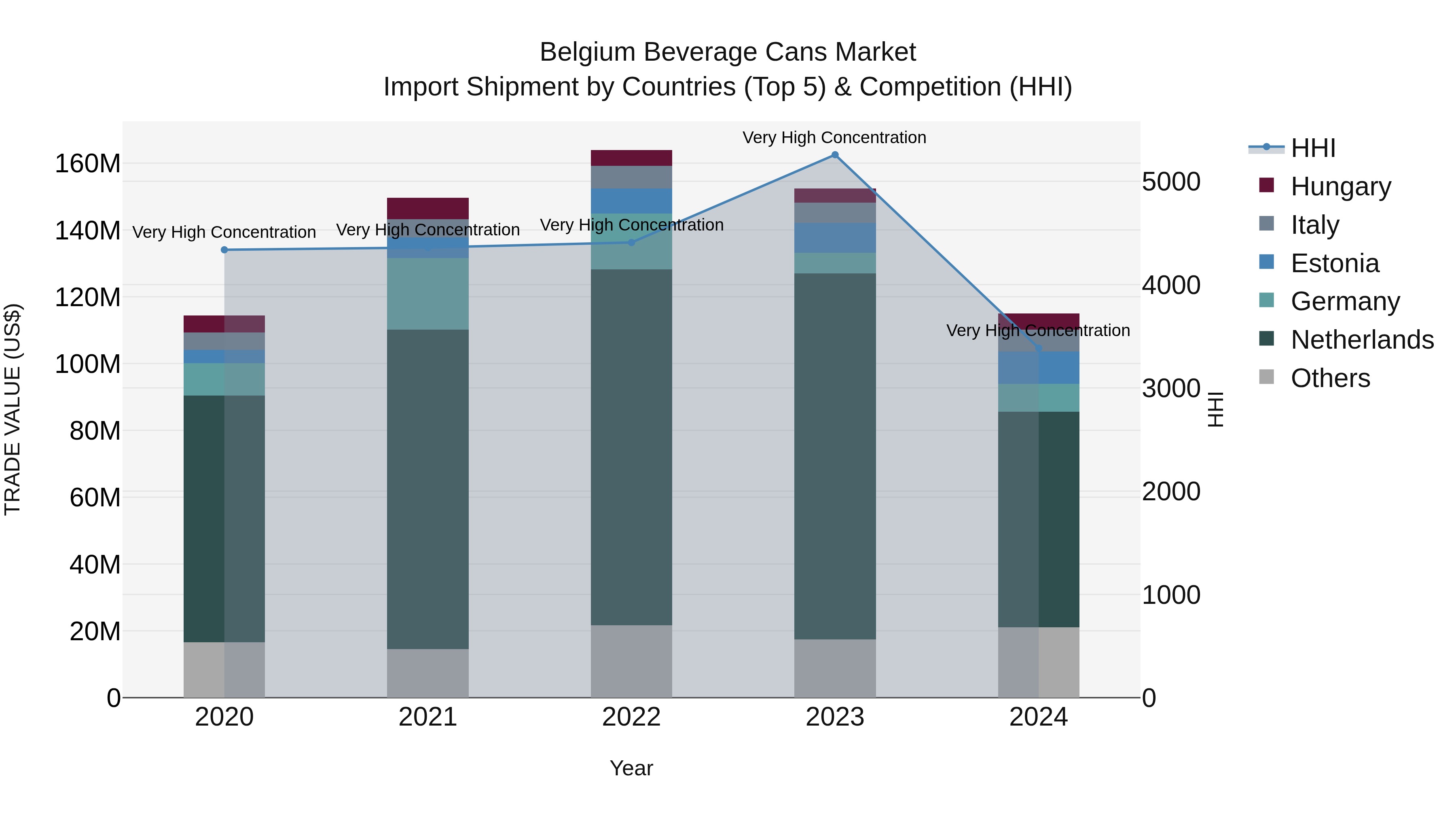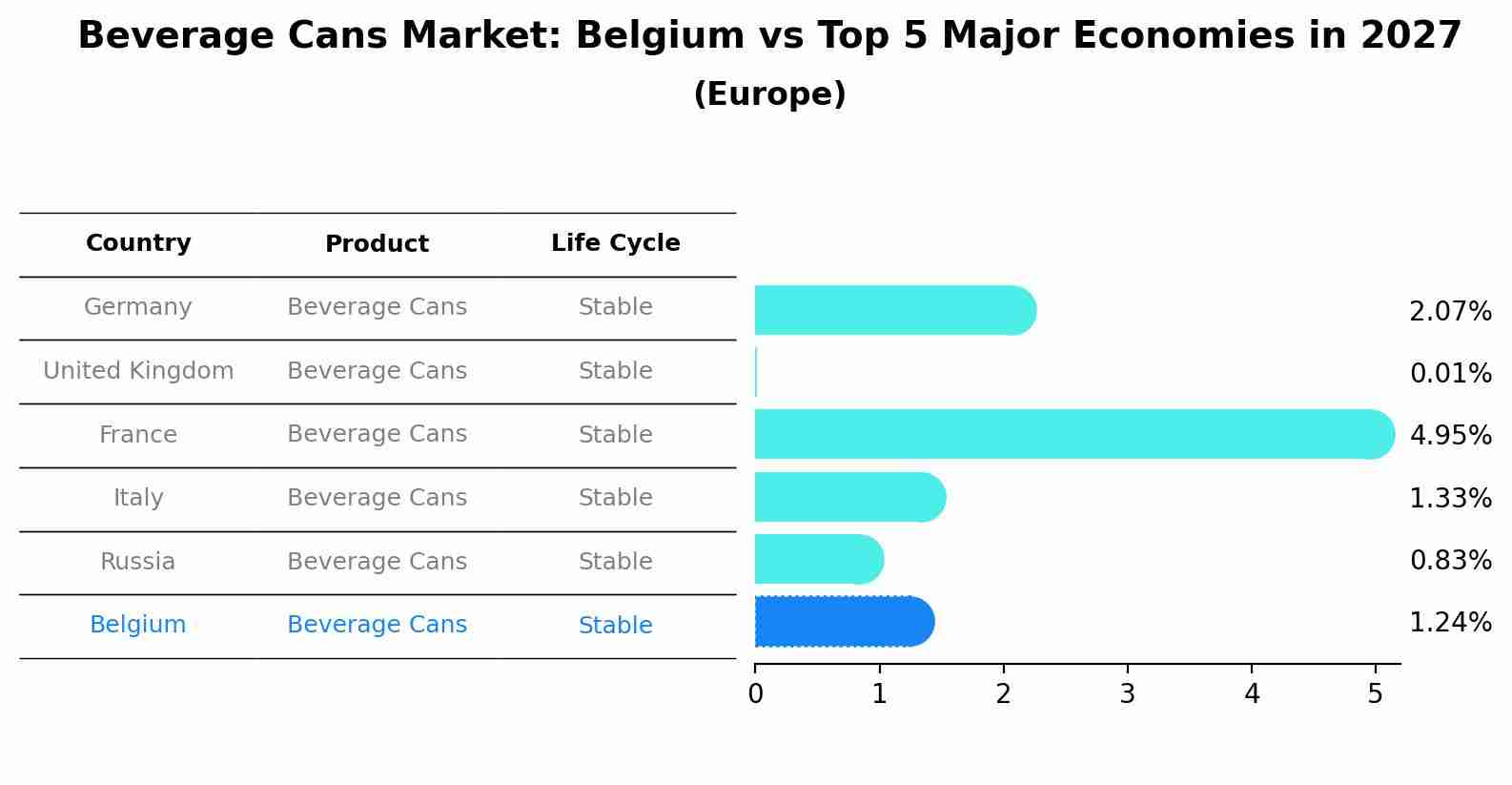Belgium Beverage Cans Market (2025-2031) | Outlook, Forecast, Size, Analysis, Companies, Trends, Segmentation, Industry, Share, Growth, Revenue & Value
| Product Code: ETC4854370 | Publication Date: Nov 2023 | Updated Date: Oct 2025 | Product Type: Market Research Report | |
| Publisher: 6Wresearch | No. of Pages: 60 | No. of Figures: 30 | No. of Tables: 5 | |
Belgium Beverage Cans Market Top 5 Importing Countries and Market Competition (HHI) Analysis
Belgium`s beverage can import market in 2024 continued to be dominated by shipments from top exporting countries such as Netherlands, Estonia, Germany, Metropolitan France, and Italy. The high concentration levels, as indicated by the Herfindahl-Hirschman Index (HHI), reflect the significant market share held by these key exporting countries. Despite a modest compound annual growth rate (CAGR) of 0.13% from 2020 to 2024, the market experienced a notable decline in growth rate from 2023 to 2024 at -24.56%. This data suggests a challenging environment for beverage can imports in Belgium, highlighting potential shifts in consumer demand or supply chain dynamics.

Beverage Cans Market: Belgium vs Top 5 Major Economies in 2027 (Europe)
By 2027, Belgium's Beverage Cans market is forecasted to achieve a stable growth rate of 1.24%, with Germany leading the Europe region, followed by United Kingdom, France, Italy and Russia.

Key Highlights of the Report:
- Belgium Beverage Cans Market Outlook
- Market Size of Belgium Beverage Cans Market, 2024
- Forecast of Belgium Beverage Cans Market, 2031
- Historical Data and Forecast of Belgium Beverage Cans Revenues & Volume for the Period 2021-2031
- Belgium Beverage Cans Market Trend Evolution
- Belgium Beverage Cans Market Drivers and Challenges
- Belgium Beverage Cans Price Trends
- Belgium Beverage Cans Porter`s Five Forces
- Belgium Beverage Cans Industry Life Cycle
- Historical Data and Forecast of Belgium Beverage Cans Market Revenues & Volume By Product Type for the Period 2021-2031
- Historical Data and Forecast of Belgium Beverage Cans Market Revenues & Volume By Aluminium for the Period 2021-2031
- Historical Data and Forecast of Belgium Beverage Cans Market Revenues & Volume By Steel for the Period 2021-2031
- Historical Data and Forecast of Belgium Beverage Cans Market Revenues & Volume By Application for the Period 2021-2031
- Historical Data and Forecast of Belgium Beverage Cans Market Revenues & Volume By Carbonated Water for the Period 2021-2031
- Historical Data and Forecast of Belgium Beverage Cans Market Revenues & Volume By Flavored Water for the Period 2021-2031
- Historical Data and Forecast of Belgium Beverage Cans Market Revenues & Volume By Still Water for the Period 2021-2031
- Historical Data and Forecast of Belgium Beverage Cans Market Revenues & Volume By Functional Water for the Period 2021-2031
- Belgium Beverage Cans Import Export Trade Statistics
- Market Opportunity Assessment By Product Type
- Market Opportunity Assessment By Application
- Belgium Beverage Cans Top Companies Market Share
- Belgium Beverage Cans Competitive Benchmarking By Technical and Operational Parameters
- Belgium Beverage Cans Company Profiles
- Belgium Beverage Cans Key Strategic Recommendations
Frequently Asked Questions About the Market Study (FAQs):
1 Executive Summary |
2 Introduction |
2.1 Key Highlights of the Report |
2.2 Report Description |
2.3 Market Scope & Segmentation |
2.4 Research Methodology |
2.5 Assumptions |
3 Belgium Beverage Cans Market Overview |
3.1 Belgium Country Macro Economic Indicators |
3.2 Belgium Beverage Cans Market Revenues & Volume, 2021 & 2031F |
3.3 Belgium Beverage Cans Market - Industry Life Cycle |
3.4 Belgium Beverage Cans Market - Porter's Five Forces |
3.5 Belgium Beverage Cans Market Revenues & Volume Share, By Product Type, 2021 & 2031F |
3.6 Belgium Beverage Cans Market Revenues & Volume Share, By Application, 2021 & 2031F |
4 Belgium Beverage Cans Market Dynamics |
4.1 Impact Analysis |
4.2 Market Drivers |
4.2.1 Increasing demand for convenient and sustainable packaging solutions |
4.2.2 Innovation in can design and material to enhance product differentiation |
4.2.3 Growing consumer preference for canned beverages over other packaging formats |
4.3 Market Restraints |
4.3.1 Fluctuating raw material prices impacting production costs |
4.3.2 Stringent regulations around recycling and sustainability |
4.3.3 Competition from alternative packaging solutions like glass bottles or PET bottles |
5 Belgium Beverage Cans Market Trends |
6 Belgium Beverage Cans Market Segmentations |
6.1 Belgium Beverage Cans Market, By Product Type |
6.1.1 Overview and Analysis |
6.1.2 Belgium Beverage Cans Market Revenues & Volume, By Aluminium, 2021-2031F |
6.1.3 Belgium Beverage Cans Market Revenues & Volume, By Steel, 2021-2031F |
6.2 Belgium Beverage Cans Market, By Application |
6.2.1 Overview and Analysis |
6.2.2 Belgium Beverage Cans Market Revenues & Volume, By Carbonated Water, 2021-2031F |
6.2.3 Belgium Beverage Cans Market Revenues & Volume, By Flavored Water, 2021-2031F |
6.2.4 Belgium Beverage Cans Market Revenues & Volume, By Still Water, 2021-2031F |
6.2.5 Belgium Beverage Cans Market Revenues & Volume, By Functional Water, 2021-2031F |
7 Belgium Beverage Cans Market Import-Export Trade Statistics |
7.1 Belgium Beverage Cans Market Export to Major Countries |
7.2 Belgium Beverage Cans Market Imports from Major Countries |
8 Belgium Beverage Cans Market Key Performance Indicators |
8.1 Recycling rate of beverage cans in Belgium |
8.2 Adoption rate of new can designs or materials in the market |
8.3 Consumer perception surveys on the convenience and sustainability of beverage cans |
9 Belgium Beverage Cans Market - Opportunity Assessment |
9.1 Belgium Beverage Cans Market Opportunity Assessment, By Product Type, 2021 & 2031F |
9.2 Belgium Beverage Cans Market Opportunity Assessment, By Application, 2021 & 2031F |
10 Belgium Beverage Cans Market - Competitive Landscape |
10.1 Belgium Beverage Cans Market Revenue Share, By Companies, 2024 |
10.2 Belgium Beverage Cans Market Competitive Benchmarking, By Operating and Technical Parameters |
11 Company Profiles |
12 Recommendations | 13 Disclaimer |
- Single User License$ 1,995
- Department License$ 2,400
- Site License$ 3,120
- Global License$ 3,795
Search
Related Reports
- ASEAN Bearings Market (2025-2031) | Strategy, Consumer Insights, Analysis, Investment Trends, Opportunities, Growth, Size, Share, Industry, Revenue, Segments, Value, Segmentation, Supply, Forecast, Restraints, Outlook, Competition, Drivers, Trends, Demand, Pricing Analysis, Competitive, Strategic Insights, Companies, Challenges
- Europe Flooring Market (2025-2031) | Outlook, Share, Industry, Trends, Forecast, Companies, Revenue, Size, Analysis, Growth & Value
- Saudi Arabia Manlift Market (2025-2031) | Outlook, Size, Growth, Trends, Companies, Industry, Revenue, Value, Share, Forecast & Analysis
- Uganda Excavator, Crane, and Wheel Loaders Market (2025-2031) | Strategy, Consumer Insights, Analysis, Investment Trends, Opportunities, Growth, Size, Share, Industry, Revenue, Segments, Value, Segmentation, Supply, Forecast, Restraints, Outlook, Competition, Drivers, Trends, Demand, Pricing Analysis, Competitive, Strategic Insights, Companies, Challenges
- Rwanda Excavator, Crane, and Wheel Loaders Market (2025-2031) | Strategy, Consumer Insights, Analysis, Investment Trends, Opportunities, Growth, Size, Share, Industry, Revenue, Segments, Value, Segmentation, Supply, Forecast, Restraints, Outlook, Competition, Drivers, Trends, Demand, Pricing Analysis, Competitive, Strategic Insights, Companies, Challenges
- Kenya Excavator, Crane, and Wheel Loaders Market (2025-2031) | Strategy, Consumer Insights, Analysis, Investment Trends, Opportunities, Growth, Size, Share, Industry, Revenue, Segments, Value, Segmentation, Supply, Forecast, Restraints, Outlook, Competition, Drivers, Trends, Demand, Pricing Analysis, Competitive, Strategic Insights, Companies, Challenges
- Angola Excavator, Crane, and Wheel Loaders Market (2025-2031) | Strategy, Consumer Insights, Analysis, Investment Trends, Opportunities, Growth, Size, Share, Industry, Revenue, Segments, Value, Segmentation, Supply, Forecast, Restraints, Outlook, Competition, Drivers, Trends, Demand, Pricing Analysis, Competitive, Strategic Insights, Companies, Challenges
- Israel Intelligent Transport System Market (2025-2031) | Strategy, Consumer Insights, Analysis, Investment Trends, Opportunities, Growth, Size, Share, Industry, Revenue, Segments, Value, Segmentation, Supply, Forecast, Restraints, Outlook, Competition, Drivers, Trends, Demand, Pricing Analysis, Competitive, Strategic Insights, Companies, Challenges
- Uganda Precast and Aggregate Market (2025-2031) | Strategy, Consumer Insights, Analysis, Investment Trends, Opportunities, Growth, Size, Share, Industry, Revenue, Segments, Value, Segmentation, Supply, Forecast, Restraints, Outlook, Competition, Drivers, Trends, Demand, Pricing Analysis, Competitive, Strategic Insights, Companies, Challenges
- Australia IT Asset Disposal Market (2025-2031) | Strategy, Consumer Insights, Analysis, Investment Trends, Opportunities, Growth, Size, Share, Industry, Revenue, Segments, Value, Segmentation, Supply, Forecast, Restraints, Outlook, Competition, Drivers, Trends, Demand, Pricing Analysis, Competitive, Strategic Insights, Companies, Challenges
Industry Events and Analyst Meet
Our Clients
Whitepaper
- Middle East & Africa Commercial Security Market Click here to view more.
- Middle East & Africa Fire Safety Systems & Equipment Market Click here to view more.
- GCC Drone Market Click here to view more.
- Middle East Lighting Fixture Market Click here to view more.
- GCC Physical & Perimeter Security Market Click here to view more.
6WResearch In News
- Doha a strategic location for EV manufacturing hub: IPA Qatar
- Demand for luxury TVs surging in the GCC, says Samsung
- Empowering Growth: The Thriving Journey of Bangladesh’s Cable Industry
- Demand for luxury TVs surging in the GCC, says Samsung
- Video call with a traditional healer? Once unthinkable, it’s now common in South Africa
- Intelligent Buildings To Smooth GCC’s Path To Net Zero













